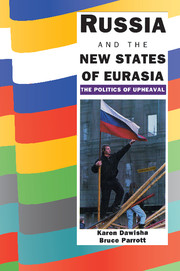Book contents
- Frontmatter
- Contents
- Preface
- Maps
- Introduction
- 1 The Legacies of History
- 2 National Identity and Ethnicity
- 3 The Impact of Religion
- 4 Political Culture and Civil Society
- 5 The Impact of Economics
- 6 Foreign Policy Priorities and Institutions
- 7 Military Issues
- 8 The Nuclear Factor
- Conclusion
- Appendix A Chronology of Events, January 1992 to October 1993
- Appendix B Compendium of Leadership and Institutional Changes in the Eurasian States, January 1992 to October 1993
- Appendix C Soviet Census Data, Union Republic and ASSR, 1989
- Notes
- Index
Appendix B - Compendium of Leadership and Institutional Changes in the Eurasian States, January 1992 to October 1993
Published online by Cambridge University Press: 06 July 2010
- Frontmatter
- Contents
- Preface
- Maps
- Introduction
- 1 The Legacies of History
- 2 National Identity and Ethnicity
- 3 The Impact of Religion
- 4 Political Culture and Civil Society
- 5 The Impact of Economics
- 6 Foreign Policy Priorities and Institutions
- 7 Military Issues
- 8 The Nuclear Factor
- Conclusion
- Appendix A Chronology of Events, January 1992 to October 1993
- Appendix B Compendium of Leadership and Institutional Changes in the Eurasian States, January 1992 to October 1993
- Appendix C Soviet Census Data, Union Republic and ASSR, 1989
- Notes
- Index
Summary
Political figures are those holding the positions identified as of 7 October 1993.
Armenia
PRESIDENT: Levon Ter-Petrossyan
VICE-PRESIDENT: Gagik Arutyunyan
PRIME MINISTER: Hrant Bagratyan
SPEAKER OF PARLIAMENT: Babken Ararktssyan
FOREIGN MINISTER: Vahan Papazyan
DEFENSE MINISTER: Sergey Sarkissyan
INTERNAL AFFAIRS MINISTER: Vanik Siradegyan
SECURITY MINISTER: Eduard Simonyants
CHAIRMAN, FOREIGN AFFAIRS COMMITTEE: David Vartanyan
CHAIRMAN, DEFENSE AFFAIRS COMMITTEE: Gevork Bagdasaryan
Elections to the 240-seat, unicameral Armenian Supreme Council were held in May 1990; in July 1991 the parliament created the posts of president, vicepresident, and prime minister. On 16 October 1991, Armenian National Movement candidate Levon Ter-Petrossyan, then parliamentary chairman, was elected president with more than 80 percent of the vote. Relations between the government and parliament grew tense in 1992, erupting in late April after the parliament rejected for the third time the government's economic program. Prime Minister Gagik Arutyunyan submitted his resignation in protest, but Ter-Petrossyan refused to accept it. The parliamentary opposition, led by the Armenian Revolutionary Federation (the Dashnaks), united to form the National Alliance bloc, and organized massive rallies calling for Ter-Petrossyan's resignation over his refusal formally to recognize the independence of Nagorno- Karabakh. On 30 July, Khosrov Arutyunyan was named prime minister, succeeding Vice-President Gagik Arutyunyan, who had also been serving as acting prime minister since November 1991. Fighting in Nagorno-Karabakh in August set off demonstrations demanding a national referendum of confidence in Ter- Petrossyan's leadership. The parliamentary opposition declined to vote for the referendum when Ter-Petrossyan announced that if he won, he would dissolve parliament and hold new elections.
- Type
- Chapter
- Information
- Russia and the New States of EurasiaThe Politics of Upheaval, pp. 310 - 330Publisher: Cambridge University PressPrint publication year: 1994



